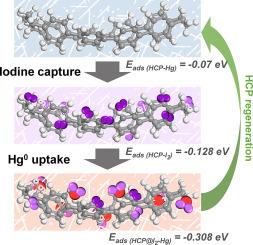Kill two birds with one stone: Waste polystyrene-derived hyper-cross-linked polymer enabling cascade uptake of iodine and mercury vapor
IF 9
1区 工程技术
Q1 ENGINEERING, CHEMICAL
引用次数: 0
Abstract
Halogen-assisted pathways offer a promising route to low-temperature control of elemental mercury (Hg0) in flue gas by oxidizing Hg0 and stabilizing Hg-halogen species within porous hosts. Here we report a waste-polystyrene-derived hyper-cross-linked polymer (HCP) engineered for a sequential iodine to mercury capture protocol in a single, regenerable platform. Due to its porous structure, the HCP achieves an iodine adsorption capacity of 2 g/g within 248 h. The iodine-laden HCP (HCP-I2-2h) demonstrates exceptional Hg0 removal performance, achieving 100 % efficiency in 4 h and maintaining >96 % efficiency under ultrahigh gas hourly space velocity (9 × 105 h−1). HCP-I2-2h shows the Hg0 adsorption rate of 8.65 × 10−6 g·mg−1·min−1, exceeding those of previously reported polymer-based sorbents by 4–7 fold. Sequential adsorption enables sustainable regeneration: Hg0-saturated HCP-I2-2h can be regenerated via ultrasonic cleaning with ethanol-KI solution, refreshing the HCP skeleton for cyclic reuse. Density functional theory calculations reveal an average adsorption energy of −0.375 eV between Hg0 and the iodine-laden HCP, 2.35 times stronger than the interaction of iodine and HCP (−0.135 eV). This adsorption hierarchy validates the feasibility of recyclability. This work establishes a tandem iodine-activation strategy on a low-cost microporous polymer, providing design rules for coupling halogen chemistry with porous-polymer architectures to deliver regenerable sorbents for flue-gas Hg0 control.

一举两得:废弃的聚苯乙烯衍生的超交联聚合物可以级联吸收碘和汞蒸气
卤素辅助途径为低温控制烟气中单质汞(Hg0)提供了一条有希望的途径,通过氧化Hg0并稳定多孔寄主内的hg -卤素物种。在这里,我们报告了一种废物聚苯乙烯衍生的超交联聚合物(HCP),用于在单一可再生平台上进行顺序碘到汞捕获方案。由于其多孔结构,HCP在248 h内达到2 g/g的碘吸附量。负载碘的HCP (HCP- i2 -2h)表现出优异的Hg0去除性能,在4 h内达到100 %的效率,在超高气体小时空速(9 × 105 h−1)下保持96 %的效率。HCP-I2-2h对Hg0的吸附率为8.65 × 10−6 g·mg−1·min−1,是先前报道的聚合物基吸附剂的4-7倍。顺序吸附实现可持续再生:hg0饱和的HCP- i2 -2h可以通过乙醇- ki溶液的超声波清洗再生,刷新HCP骨架,循环再利用。密度泛函理论计算表明,Hg0与负载碘的HCP之间的平均吸附能为−0.375 eV,是碘与HCP相互作用能(−0.135 eV)的2.35倍。这种吸附层次结构验证了可回收性的可行性。本研究在低成本微孔聚合物上建立了串联碘活化策略,为卤素化学与多孔聚合物结构的耦合提供了设计规则,以提供可再生的吸附剂,用于烟气Hg0控制。
本文章由计算机程序翻译,如有差异,请以英文原文为准。
求助全文
约1分钟内获得全文
求助全文
来源期刊

Separation and Purification Technology
工程技术-工程:化工
CiteScore
14.00
自引率
12.80%
发文量
2347
审稿时长
43 days
期刊介绍:
Separation and Purification Technology is a premier journal committed to sharing innovative methods for separation and purification in chemical and environmental engineering, encompassing both homogeneous solutions and heterogeneous mixtures. Our scope includes the separation and/or purification of liquids, vapors, and gases, as well as carbon capture and separation techniques. However, it's important to note that methods solely intended for analytical purposes are not within the scope of the journal. Additionally, disciplines such as soil science, polymer science, and metallurgy fall outside the purview of Separation and Purification Technology. Join us in advancing the field of separation and purification methods for sustainable solutions in chemical and environmental engineering.
 求助内容:
求助内容: 应助结果提醒方式:
应助结果提醒方式:


